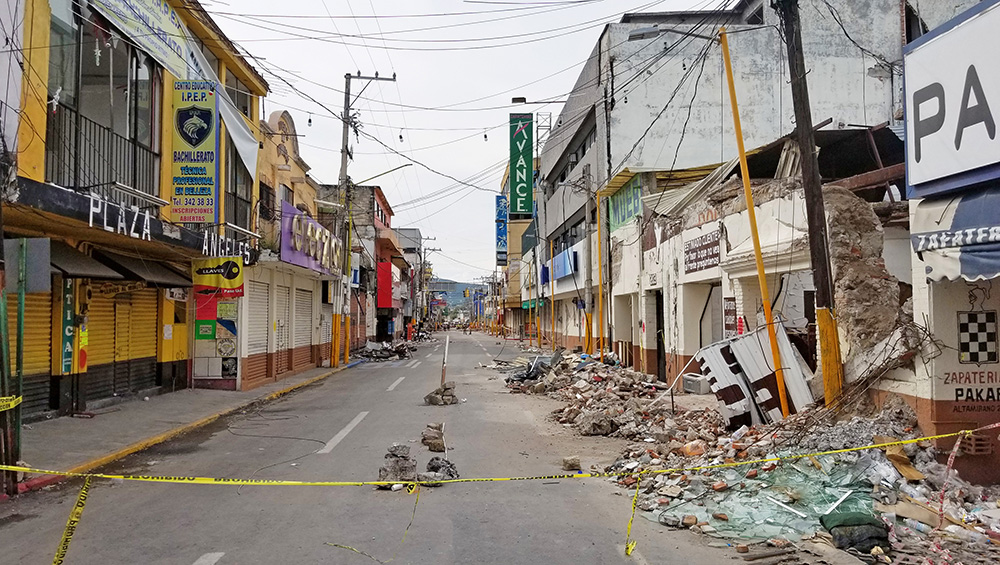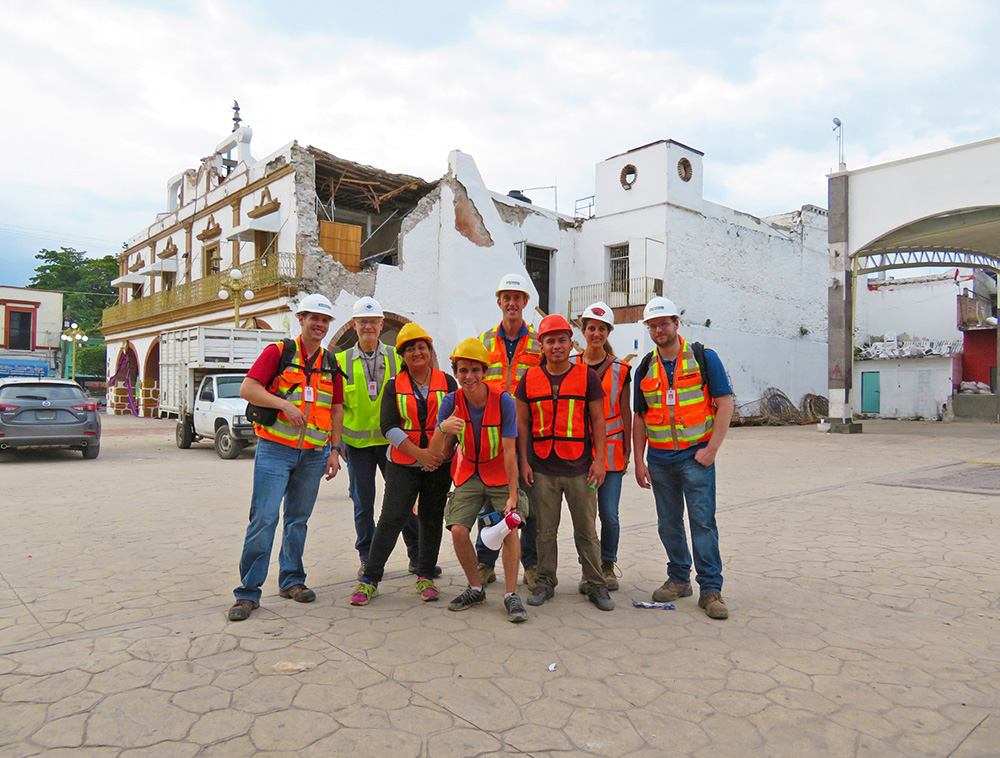Thursday, October 5, 2017
I write our last blog in the México Earthquake Reconnaissance series while en route home, passing over the incomprehensibly expansive city once again. It has been a whirlwind of long days lleno (full) of field observations, meetings, discussions, processing, countless touching interactions with locals, team logistics coordinating, patting my steps count stats, practicing mi Español, rinse, lather, and repeat (the bathing particularly needed). All of that to say that this blog is “hot of the cerebral press” and we have not yet thoroughly organized, processed, analyzed the data to formulate lessons learned from the week; this is a preliminary summary of our thoughts and observations in the field.
Why Earthquake Reconnaissance?
Before attempting to organize a few thoughts from the field, you may be wondering, “Why does Reid Middleton make such a significant investment in this earthquake reconnaissance thing? Can’t they just read the reports like everyone else?” Let me answer by revisiting our internal stated goals when planning this effort:

A. Learn. We endeavor to be experts in our field, and we seek to provide our clients and colleagues with tangible, practical, relevant advice based on this expertise. These events are a real-world laboratory in which the abstract theories of earthquake engineering play out in real life, with real structures, affecting real people. They are a reminder that the details matter, and why we as structural engineers are in the business of promoting public safety and welfare. For me, participating in earthquake reconnaissance in the formative years of my career have been profound, shaping the trajectory of my career, and instilling a perspective and passion for earthquake engineering that I wouldn’t have found otherwise.

B. Assist. To the extent possible, we endeavor to assist in the important work of safety evaluations for buildings to get people back into homes and workplaces, and keep them out of unsafe structures. At a minimum, we hope to stay out of the way and not be an extra burden on the system. As part of our reconnaissance efforts, our team had the opportunity to collaborate with the Casa de Arquitectos, Protección Civil, and Colegio de Ingenieros Civiles to assist with evaluations, data collection, and information sharing from our work
C. Share. A. The stories and lessons from these events must be told. We endeavor to collaborate with others in the industry, at home and abroad, and to disseminate the important lessons learned from our time in the field. We strive to document and share the stories we learned from the event, from specific technical details, to examples of human selflessness and resiliency that represent the best of humanity. We look forward to connecting with you to share more.

Lifeline Performance Observations
In addition to studying “traditional” structural/building damage, as discussed in several previous blogs, one of our expressed objectives was to study the performance of lifeline systems and critical community functions. Based on our limited first-hand observations, on-site conversations, and research, the following is a summary of our preliminary understanding of the performance of lifeline systems following the M7.1 event:

- Water System: providing reliable water service and water supply resilience was an on-going challenge for the Ciudad de México (CDMX, as they abbreviate it) prior to the earthquake. This is partially due to the unique complexity of the city’s geology, with reports of some areas “sinking” 30cm a year! In many areas of the city, water is unreliable. As a result of the event, several transmission pipelines were damage and many communities did not have access to water service a week after the event. Often times, these were in less affluent and less influential areas of the CDMX.
- Wastewater System: although the system experienced some damage, including at treatment plants and transmission lines, the wastewater system was nominally operating at pre-event levels immediately after the event. However, we are still researching to understand the affects or disruptions that this damage may have on the performance of the system.
- Power Supply System: although we heard first-hand reports that there was some damage at several substations, we understand that the power was mostly functional after the event. However, we were told that damage/collapsed buildings caused localized interruption to electricity in many areas.
- Telecom System: we understand that the telecom system remained mostly functional after the event in CDMX (see Day 11 blog, for reference). However, we also were told that more rural areas, such as Jojutla, did not have communication for 3-4 days after the earthquake until the local telecom companies installed a new temporary tower.
- Transportation System: we have read reports that five of the city’s 13 metro lines were closed immediately after the earthquake due to electricity failure, but the service was quickly restored. In fact, we were informed that public transportation systems were free or operating with reduced fares immediately after the event. Otherwise, we are not aware of significant damage/interruption to the transportation system in CDMX after the event, aside from rerouting traffic around damaged buildings. However, we did observe some interruptions to the transportation system outside of CDMX due to bridge damage and geotechnical failures, including damage to roads and bridges in the nearby state of Morelos. Also, we understand that the MEX airport was closed for approximately three hours immediately after the earthquake.
- Healthcare System: we observed several hospitals that were damaged due to nonstructural damage, loss of water service (ostensibly), and minor structural damage. Local newspapers reported that the operations of 600+ healthcare facilities were affected on some level, including clinics, hospitals, and medical office buildings. However, we are not aware of hospitals that suffered extreme structural damage or collapse.
- Education System: we visited several schools that were undamaged, but we also observed several schools that suffered severe damage or collapse. Local newspapers reported that nearly 1,000 schools suffered some form of damage, seven of which will require total reconstruction.
General Reconnaissance Observations
With that in mind, I’ll share a few initial collective thoughts and observations that our teams had while in the field the past two weeks:
1. This was a very unique event with focused damage. As you may have read in prior posts, the damage that we observed was concentrated and focused, both regionally and locally. For example, we were surprised to learn that the town of Puebla had relatively minimal damage, while the town of Jojutla (with equivalent proximity to the earthquake source) was rather devastated. However, even within the town of Jojutla, as an example, there were streets/blocks that were mostly destroyed while adjacent streets/blocks remained largely undamaged. Similarly, within Mexico City, the damage was extremely localized. We were not surprised to see significantly more damage on the lakebed compared to on more competent soils, due to the dynamic amplification of the soft soils. Even within CDMX, there were neighborhoods that had somewhat uniform, ubiquitous damage while others with similar infrastructure appeared untouched. This particular region has very unique technical, seismological, and geotechnical phenomena and there is a lot to learn from studying this event.

2. Organic Community Organizing. Some of the most impressive and profound observations were that of local communities organizing responses in incredibly impressive, selfless, organic, and unified ways. Por ejemplo:
- Urban search and rescue efforts at collapsed buildings that were led entirely by volunteers from México and abroad. We met a miner who left his hometown to put his life in significant danger to assist with rescue efforts. Abuelas started making food in tents nearby for volunteers. An organic community showed up and organized. Amidst some of the worst suffering imaginable, snippets of incredible beauty emerged.
- In Jojutla, we met a team of students who came from CDMX to help out. They found themselves leading the grassroots effort of receiving/distributing donated resources, organizing demolition/repairs, and serving as a local focal point for this devastated community. These are 19-year-old kids! Say what you will about millennials, but the leadership, strength, and generosity of these youth are surpassed by none.
- We had the opportunity to collaborate with several students at the fulcrum of the emergency operations center within the Colegio de Ingenieros Civiles, where the building evaluations are organized, documented, and distributed. Again, these are college students running the show, sacrificially donating their time/energy, and exhibiting impressive leadership.


3. Real-World Resilience. “Resilience” is the current buzz word of the industry; we enjoy talking about it, researching it, analyzing it, promoting it, etc. However, resiliency is an extremely complex, comprehensive, and abstract concept and I’m not sure if most of us in the engineering community really know what it truly means. We saw a glimpse of it in CDMX.
Don’t get me wrong – not everything performed as desired and there is certainly a lot of room for improvement. And for those directly affected by the failures, it was tragically devastating. However, taking a step back, we saw a community that took a punch but is still standing. Even in Jojutla, where we were told that upwards of ½ of the buildings were damage/collapsed, life continues to go on.
It’s easy to point out what went wrong. Let’s be honest – the engineering community often falls into the same trap as the media in this regard. Dramatic damage photos are more “interesting” than intact buildings. While the statistics are still pouring in, I am confident that only a small percentage of the buildings and infrastructure in CDMX were severely damaged or collapsed. We were told that after the 1985 event, life was essentially suspended for months; no one was in the streets. Today, in many parts of Mexico City, it’s hard to tell there was an earthquake there. This is in large part because they paid attention to the lessons learned from 1985, developed better codes/standards, implemented technologies (e.g. seismic instrumentation and early-warning systems), invested in infrastructure, and educated themselves on how to become more resilient.
I hope that we can do the same and emulate the #FuerzaMexico.

Thanks for reading. Please feel free to contact us if you have any questions or would like to learn more.


